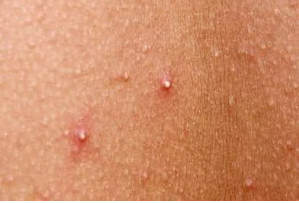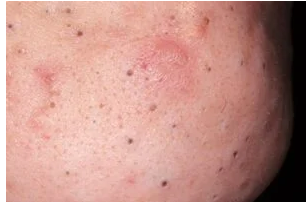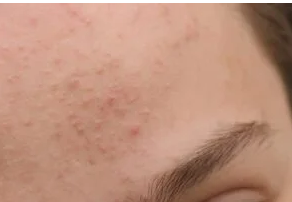
Acne, the complex skin condition it is, comes in many forms. While each pimple is technically formed the same way—dead skin, oil, and debris stick together and block the pores—but from there, it can develop into various types of blemishes. Some are large, red, and tender to the touch (like cysts); others are speckled across your skin, causing textural concerns (blackheads and whiteheads).
Here, we dive into the seven types of acne, the causes, and how to best treat each spot. In terms of remedies, the tips we provide here only scratch the surface, as treating acne requires a holistic view—diet, stress, and sleep can all affect the condition, but this article will focus on specific ingredients for each blemish.

Non-Inflammatory versus Inflammatory Acne
Each type of acne technically falls into one of two categories: non-inflammatory or inflammatory though to be clear, all acne stems from some level of inflammation. A few types are more tender, puffy, and angry than others—those are classified as “inflammatory.” Papules, pustules, nodules, and cysts fall into this category, as they’re all typically red and painful.
“Non-inflammatory” acne, on the other hand, results in subtler mounds—these are your whiteheads, blackheads, and subclinical breakouts. Also known as comedonal acne, the bumps tend to be flesh-toned, aside from blackheads, which are darker in color) It is typically caused by clogged hair follicles and found where the skin is more oily, like the chest, back, and T-zone area of the face.
Non-inflammatory acne can become inflamed later on when there is an overgrowth of bacteria (specifically Cutibacterium acnes1), which can cause the release of inflammatory cytokines and messengers to create clinical inflammation. So again, all acne is inflammation on some level.
Whiteheads

Closed comedones are whiteheads; they look like tiny whitish or flesh-colored bumps on the surface of the skin. Whiteheads are not the large, tender pimples with a big pus-filled center (those are pustules, which we’ll get into later). Rather, because whiteheads are not inflamed, they are much subtler. Think small, fleshy bumps on the skin, caused by dead skin, excess oil, and overall debris blocking the pores.
How to treat it:
• AHAs or BHAs: Sloughing off the dead skin can help you avoid clogging the pores in the first place. Salicylic acid is an ideal option for oily skin (it is oil-soluble allowing it to penetrate into the pores), while AHAs like lactic acid are typically more hydrating and more suitable for those with drier or sensitive skin types.
• Retinol: Retinol and retinoids enhance the skin’s normal turnover process to prevent dead skin cells from accumulating in the pore. Osmosis Skincare offers a range of exceptional Retinal Serums utilizing pharmaceutical grade liposomal retinaldehyde and proprietary nutrients beyond the surface to feed and remodel the skin.
• Get regular peels: There may be a genetic component to nodular acne; that said, if you have a family history, regular, in-office chemical peels can help remove excess dead skin and trigger cell turnover—which, in turn, can help prevent clogged pores and nodules with time.
• Pore-clearing masks: Ingredients like activated charcoal and clay are popular in pore-clearing masks, as these draw out excess oil and gunk from the pores, thus preventing blemishes from forming.
Blackheads

Blackheads form the same way whiteheads do (when the pore becomes blocked with gunk and oil) with one difference: they’re considered open comedones. An open comedone, or blackhead, occurs when the debris is exposed to the air, whereas a closed comedone, or whitehead, occurs when the debris is just under the surface of the skin and not exposed to the air. That oxygen exposure is what makes them turn dark in color.
How to treat it.
Blackheads and whiteheads are cut from the same cloth (aside from the oxidation of the plug), so you can treat them pretty similarly:
• AHAs, BHAs & clays: Cleansers with salicylic acid, clay masks, and chemical exfoliants with alpha- and beta-hydroxy acids can all help to exfoliate the skin and make your skin less prone to developing blackheads. An excellent option here is Osmosis Skincare’s Deep, a detoxifying cleanser that works to remove deep impurities and promotes an invigorating clean.
• Blackhead removers: You can find a slew of market products dedicated to this very issue, from daily toners to blackhead masks to treatment gels (you won’t find any pore strips—as those do not actually unclog the plug at its source).
• DIY masks:�Plenty of natural ingredients can gently dissolve dead skin cells and lift debris from the pores, including Cranberry Enzyme, a key ingredient in Osmosis Skincare’s Cranberry Enzyme Mask.
Subclinical acne

While subclinical acne is not a term used in dermatology, it’s used enough in skin care conversations to earn a spot on our list. Essentially, it’s a fancy way of saying “congested skin,” and it’s synonymous with whiteheads.
These flesh-colored bumps never seem to come to a “head,” but they can progress into pimples or pustules if they become inflamed—which can happen if they’re left untreated. They are non-painful and usually do not lead to scarring or skin discoloration.
How to treat it:
• Salicylic acid:�BHAs are superb for comedonal acne, as the ingredient can penetrate deep into the pores and help break up the pore-clogging material.
• Retinol: Again, retinol is A+ for preventing comedones as well. Topical retinoids have a comedolytic effect, meaning that they help to prevent and treat clogged pores. This is the result of their ability to increase the turnover of skin cells and reduce the tendency of cells and keratin debris to clump together.
• Benzoyl peroxide:�Benzoyl peroxide can kill acne-causing bacteria and help break up pore-clogging agents, like dead skin cells (which can lead to subclinical acne). If you do use retinols, stick to a benzoyl peroxide face wash in the morning, so you can apply retinol at night as when benzoyl peroxide and retinoids (or retinols) are used in combination, they interact causing both to be less effective.
• Get regular peels: There may be a genetic component to nodular acne; that said, if you have a family history, regular, in-office chemical peels can help remove excess dead skin and trigger cell turnover—which, in turn, can help prevent clogged pores and nodules with time.
Papules
• Benzoyl peroxide:�It kills the acne-causing bacteria, P. acnes, that lives within our hair follicles, and it also helps to break up and remove dead skin cells that clog our pores. This makes the benzoyl peroxide especially helpful for angry papules—it canhelp with comedonal acne but is mainly hailed for shrinking inflammatory pimples.
• Tea tree oil:�Tea tree oil has antimicrobial properties and is capable of lowering levels of acne-causing bacteria on the skin when applied to acne lesions. In fact, one double-blind placebo-controlled study found that a 5% tea tree oil gel blend was an effective treatment for mild to moderate acne4. Plus, tea tree oil is anti-inflammatory, which means it has the ability to soothe and relieve irritated, itchy, red, swollen skin. Tea tree oil should always be diluted the potent essential oil with a carrier—you never want to apply it directly to the skin.
• Blue Light Therapy: Blue light therapy that uses light in the 415 nm range is absorbed by porphyrin. The bacteria causing acne, P. acnes�contains abundant levels of porphyrin and when the blue light is absorbed an oxygen free-radical is created which is released into the bacteria, killing the bacteria.
Pustules
• Spot treat:�If you have a spot treatment, serum, or mask, that features acne-fighting ingredients (retinol, salicylic acid, tea tree oil, benzoyl peroxide, witch hazel, etc.) such as Osmosis Clarify Retinal Serum, you can always tap it onto the blemish before bed. It’s a great tip to shrink pimples overnight, as the extra dose can help unclog pores and treat the breakout.
• Blue Light Therapy: As mentioned above, blue light in the 415 nm range is absorbed by porphyrin. The bacteria causing acne, P. acnes�contains abundant levels of porphyrin and when the blue light is absorbed an oxygen free-radical is created which is released into the bacteria, killing the bacteria.
Nodules
• Get regular peels: There may be a genetic component to nodular acne; that said, if you have a family history, regular, in-office chemical peels can help remove excess dead skin and trigger cell turnover—which, in turn, can help prevent clogged pores and nodules with time.
• Look for brightening ingredients:�Nodules have a higher risk of scarring. If you notice some scarring or hyperpigmentation, brightening ingredients (think vitamin C or arbutin) can help fade those marks over time. Osmosis Catalyst AC-11 DNA Repair Serum is an exceptional option. This clinically rpoven serum activates the repair mechanisms of our own cells to reverse aging, reduce pigmentation, decrease scar tissue, clear capillaries, and increase skin elasticity.
How to treat it:
• Chamomile:�This botanical has been an age-old remedy for treating wounds and skin irritations in traditional medicine, and its anti-inflammatory properties may help reduce the painful swelling. When used in topical skin care products, chamomile can help calm and soothe the skin.
Because the inflammation associated with Cystic Acne is so deep, cysts are more prone to scarring. While we’ve repeatedly discussed retinol’s ability to prevent blemishes and breakouts, it can also help decrease acne scarring as well. In addition to exfoliating dead skin cells, retinoid blocks the activity of enzymes behind melanin synthesis, resulting in a more even skin tone. Again we recommend Osmosis Clarify Retinal Serum for the treatment of acne.
• See an esthetician and/or dermatologist:�While diet, stress reduction and other at-home methods can help, they shouldn’t be your only plan of action. At the end of the day, cystic acne should always be treated in conjunction with a professional, and the very worst thing you can do for cystic breakouts is to touch, squeeze, or try to pop the lesions.
The Takeaway
Acne is a complex skin condition with several triggers and contributing factors—you can’t expect to treat each spot the same way. Some ingredients are better suited than others for each type of acne, which is why classifying your blemishes is a solid place to start Any treatment plan should include diet, stess reduction, and other lifestyle factors.
